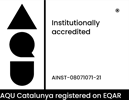

Quantitative Methods for Spatial Economics
Exploring quantitative spatial models: Methods, challenges, and policy implications in spatial economics
Course overview
The availability of highly disaggregated spatial data and the development of new methods have revolutionized the field of spatial economics, or economic geography, over the last few years.
This course offers an overview of state-of-the-art models of the spatial economy, which are often referred to as quantitative spatial models (QSM). It focuses on the set of economic questions this rapidly growing field seeks to answer, but also on the practical computational challenges involved in solving these models and taking them to the data.
The course is aimed at graduate students, researchers and practitioners who want to develop a working knowledge of QSM in order to answer policy-relevant questions about the geography of economic activity and its implications for the aggregate economy.
Faculty
Who is this course for?
This course targets the following profiles:
- Graduate students, researchers and practitioners who want to develop a working knowledge of QSM in order to answer policy-relevant questions.
Learning outcomes
Participants who take this course will receive:
- A comprehensive overview of state-of-the-art quantitative spatial models (QSM) and their applications.
- Skills to identify and analyze key economic questions related to the geography of economic activity.
- Practical skills to tackle the computational challenges of implementing QSM and analyzing disaggregated spatial data.
- Training in applying quantitative spatial models to real-world datasets and policy-relevant scenarios.
- Knowledge to derive policy implications from spatial economic analyses, informing decisions in the broader economy.
Key topics for Quantitative Methods for Spatial Economics course
Here is an overview of what will be covered in the program:
Course Outline
- Why does space matter? Increasing returns, transport costs and the geography of economic activity
- The importance of market access
- Quantitative urban economics
- Dynamic spatial economics
List of References
See below a list of texts and articles that may help you prepare for this course:
Articles and Books
- Ahlfeldt, G., Redding, S., Sturm, D. and Wolf, N. (2015): The economics of density: Evidence from the Berlin Wall. Econometrica 83(6), 2127-2189.
- Allen, T. and Arkolakis, C. (2014): Trade and the topography of the spatial economy. Quarterly Journal of Economics 129(3), 1085-1140.
- Allen, T., Arkolakis, C. and Li, X. (2023): On the equilibrium properties of spatial models. American Economic Review: Insights, forthcoming.
- Allen, T. and Donaldson, D. (2022): Persistence and path dependence in the spatial economy. Mimeo.
- Bleakley, H. and Lin, J. (2012): Portage and path dependence. Quarterly Journal of Economics 127(2), 587-644.
- Caliendo, L., Dvorkin, M. and Parro, F. (2019): Trade and labor market dynamics: General equilibrium analysis of the China trade shock. Econometrica 87(3), 741-835.
- Caliendo, L., Opromolla, L., Parro, F. and Sforza, A. (2021): Goods and factor market integration: A quantitative assessment of the EU enlargement. Journal of Political Economy 129(12), 3491-3545.
- Ciccone, A. and Hall, R. (1996): Productivity and the density of economic activity. American Economic Review 86(1), 54-70.
- Davis, D. and Wenstein, D. (2002): Bones, bombs, and break points: The geography of economic activity. American Economic Review 92(5), 1269-1289.
- Desmet, K., Nagy, D. and Rossi-Hansberg (2018): The geography of development. American Economic Review 104(4), 1211-1243.
- Donaldson, D. and Hornbeck, R. (2016): Railroads and American economic growth: A “market access” approach. Quarterly Journal of Economics 131(2), 799-858.
- Giannone, E. (2022): Skill-biased technical change and regional convergence. Mimeo.
- Helpman, E. (1998): The size of regions. In: Topics in public economics: Theoretical and applied analysis, ed. Pines, D., Sadka, E. and Zilcha, I. 33-54. Cambridge University Press.
- Kleinman, B., Liu, E. and Redding, S. (2023): Dynamic spatial general equilibrium. Econometrica 91(2), 385-424.
- Krugman, P. (1991): Increasing returns and economic geography. Journal of Political Economy 99(3), 483-499.
- Redding, S. (2016): Goods trade, factor mobility and welfare. Journal of International Economics 101, 148-167.
- Redding, S. and Sturm, D. (2008): The costs of remoteness: Evidence from German division and reunification. American Economic Review 98(5), 1766-1797.
- Tsivanidis, N. (2023): Evaluating the impact of urban transit infrastructure: Evidence from Bogotá’s TransMilenio. Mimeo.
Why join our Summer School?
All BSE Summer courses are taught to the same high standard as our Master’s programs. Join us to:
Network with like-minded peers
Study in vibrant Barcelona
Learn from world-renowned faculty
Admissions and requirements
Applicants must ensure they meet course requirements or verify eligibility with Admissions Counselors.
Requirements
Summer School applicants normally demonstrate one or more of the following:
- A strong background in Economics or a field closely related to the course topic (Statistics, Law, etc.)
- Postgraduate degree or current Master’s/PhD studies related to the course topic
- Relevant professional experience
Schedule
Here is your schedule for this edition of CREI Macroeconomics Summer School, Quantitative Methods for Spatial Economics course.
Credit transfers (ECTS)
- ECTS are not available for this course
Certificate of Attendance
Participants who attend more than 80% of the course will receive a Certificate of Attendance, free of charge.
Fees
Multiple course discounts are available, see more information about available discounts. Fees for courses in other Summer School programs may vary.
* Reduced Fee applies for PhD or Master’s students, Alumni of BSE Master’s programs, and participants who are unemployed.
FAQ
Here are some commonly asked questions by participants. Any further queries, please contact our Admissions Team.
Is accommodation included in the course fee?
Accommodation is not included in the course fee. Participants are responsible for finding accommodation.
Are the sessions recorded?
Sessions will NOT be recorded; however, the materials provided by the professor will be available for a month after the course has finished.
How much does each Summer School course cost?
Fees for each course may vary. Please consult each course page for accurate information.
Are there any discounts available?
Yes, BSE offers a variety of discounts on its Summer School courses. See more information about available discounts or request a personalized discount quote by email.
Can I take more than one course?
Yes! you can combine any of the Summer School courses (schedule permitting). See the full course calendar.
Are there any evening activities during the course?
A social dinner will take place during the week for all participants, it is free to attend.
Mix and match your summer courses!
Remember that you can combine this program with courses in any of the other BSE Summer School programs (schedule permitting). Maximise your learning this summer and take advantage of our multiple-course discount.
Economics. All rights reserved.






